On iPhones sold outside China and used outside China, the Google domain that gets used by Safari’s Google search bar depends on your chosen region format setting (under Settings > General > International). If your region format is set to Belgium, your results are served via google.be. If your region format is set to the United Kingdom, you get google.co.uk. Etc. This makes sense.
If you use an iPhone sold outside China inside China, the results depend on whether you use a VPN service. If you do, your region format continues to determine your Google domain (in these screenshots set to Belgium):
Hong Kong iPhone 3GS, VPN enabled, region format: Belgium:
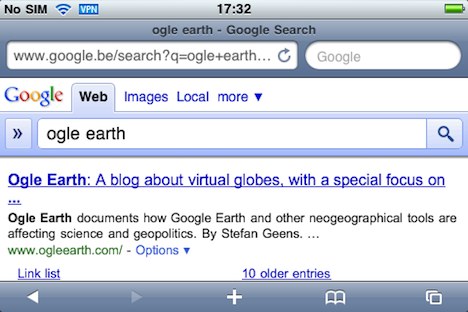
If you do not use VPN, however, all searches are automatically redirected to google.cn and are served from that domain. This is odd, because Google earlier this year announced it had stopped serving censored search results via google.cn, instead asking people to click through to google.com.hk. This is clearly not the case on my iPhone 3GS: mobile google.cn searches still work (just try this URL to see for yourself):
Hong Kong iPhone 3GS, VPN disabled, region format: Belgium:

So is Google still serving censored search results on Google.cn, despite its promise to stop, or are these search results uncensored, in defiance of Chinese law? I’m not sure, but a search for Dalai Lama yields a results page that links to the homepage of the Tibetan government in exile, and this is a website blocked in China that almost certainly would not make it into Google’s censored search results.
On the new Chinese iPhone 4, using Safari’s Google search bar leads to a different outcome. On this iPhone, it doesn’t make any difference what your region format is, whether you use VPN or not, or where in the world you use it — you are not returned your results immediately, but instead get a landing page on Google.cn that you need to click manually before you are redirected and shown your results on Google.com.hk:
Chinese iPhone 4, VPN disabled, region format: Belgium:
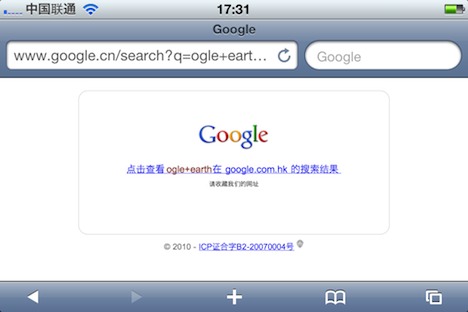
Chinese iPhone 4, VPN enabled, region format: Belgium:
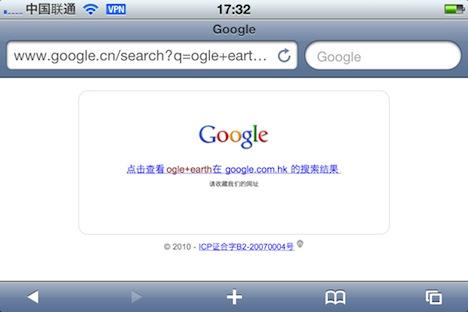
In other words, the Chinese iPhone 4 ignores your region format setting, and always returns a google.cn landing page that manually redirects you to google.com.hk. This is just aggravating, because just as with any other iPhone, you can still type in google.co.uk or .com or .be into the address bar and search that way. (And if you use VPN, your search queries won’t be filtered for sensitive words by China’s great firewall.)
As for the crippled Maps app discussed in the previous post: In response to various comments, here are some more screenshots illustrating their lack of usefulness:
In Paris, all street names are in Chinese only:

The same goes for Montreal:
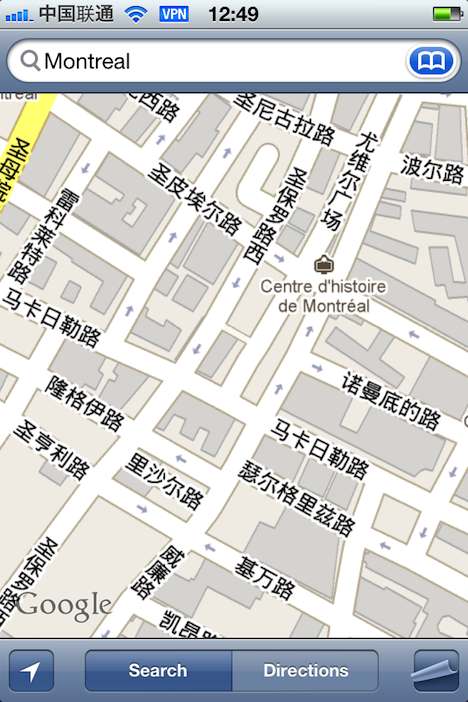
Ditto for Sydney:
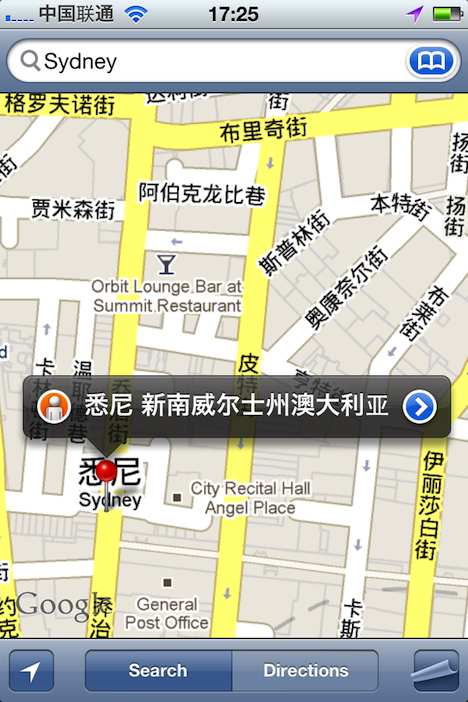
In Rome, there are no street names at all (as is the case in much of the rest of Europe):
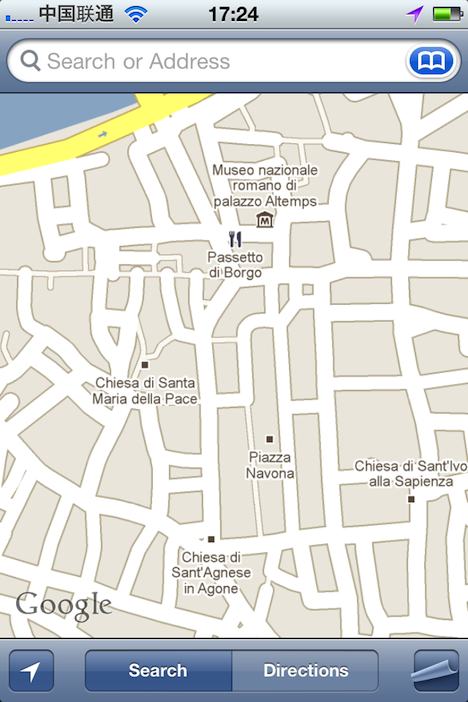
As for the Spratley islands in the South China Sea, they are definitely Chinese, as is Taiwan for good measure:
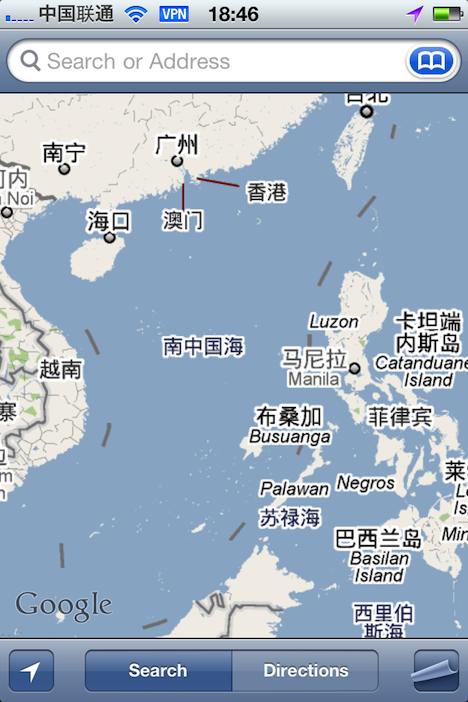
By comparison, here is what the map fit for global consumption looks like, on the Hong Kong iPhone 3GS:
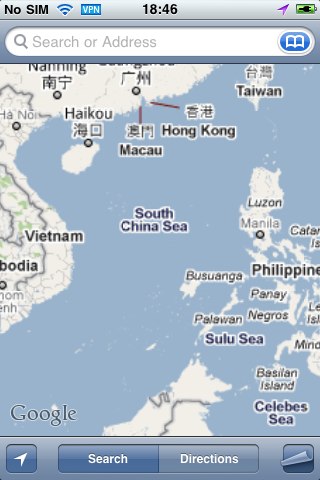
The solution is clear, at least to me: First, Google needs to go bilingual in its Chinese map dataset. Most likely the missing street names are just an oversight, and an upcoming update will address this issue with refreshed map tiles. No iPhone software update is needed for this.
Then, in iOS 4.2, give the Maps app a settings pane that lets you choose which Google Maps dataset you want: International, Chinese, or Indian. (The Indian government also has issues with Google’s borders, and demands a separate semi-fictional dataset for maps.google.co.in, where all of Kashmir is Indian-controlled and Arunachal Pradesh is not disputed by China.) I don’t care what the defaults are, as long as I can change them.
Failing that, let the region format setting determine which map gets served. Choose China, and the Chinese map dataset is served. Choose India, and get the Indian dataset. Every other region gets the reality-based map, where lines of control and disputed regions are accurately depicted.
As for Safari’s Google search bar: If I can’t choose the Google search domain via the region format or via a settings panel preference, then please add an option to remove the search bar wholesale. I’ll use Google’s search app with instead, thank you very much.
Is that too much to ask? It would appease paranoid governments while giving users the ability to choose the information frameworks most pleasing to their own personal biases.
[Update 2010-09-28 13:06 UTC: As far as I can tell, the map dataset hardwired to my Chinese iPhone is identical to the one being served at ditu.google.cn, so you can explore it for yourself if you like. On a desktop computer, the lack of street names is perhaps not so glaring an omission. On a mobile device traveling to one of these cities, however, it’s a dealbreaker.]
sorry, bucks are far more important than principles or functionality for companies in this era. expect no changes.
The hardware sold in China is exactly the same as the rest of the world in model A1332 apparently. The only difference is the Chinese software/OS/ROM Apple has loaded in the devices sold there per serial # to comply with Chinese regulations. This is easily changeable by jailbreaking. Wait until the jailbreak is released and change the iPhone ROM to the one of your home country (EU, US, HK, etc…). You can also add the global maps app easily with jailbreaking.